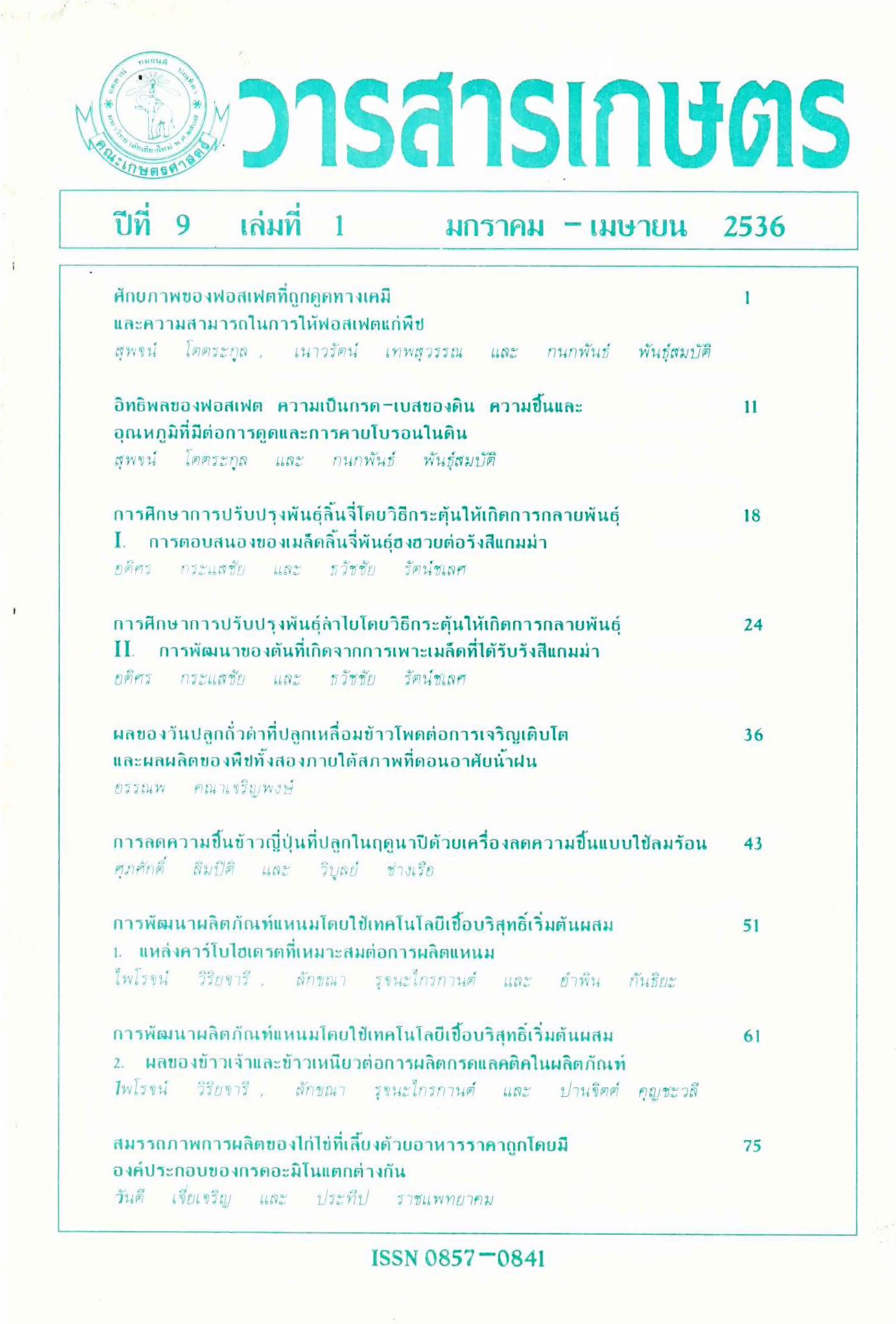สมรรถภาพการผลิตของไก่ไข่ที่เลี้ยงด้วยอาหารราคาถูกโดยมีองค์ประกอบของกรดอะมิโนแตกต่างกัน
Main Article Content
บทคัดย่อ
ไก่ไข่พันธุ์ไฮเสดจำนวน 192 ตัว อายุ 22 สัปดาห์ จัดแบ่งออกเป็น 6 พวก ๆ ละ 8 ซ้ำ ๆ ละ 4 ตัว แต่ละตัวถูกเลี้ยงในกรงตับขังเดี่ยว มีน้ำและอาหารให้กินตลอดเวลาตามแผนการทดลองแบบ Completely randomized design ไก่ไข่แต่ละพวกได้รับอาหารที่มีระดับของกรดอะมิโน ตามคำแนะนำของสุวรรณ และคณะ (2526) เป็นพวกเปรียบเทียบ, 75, 100 และ 125% ของคำแนะนำของ NRC (1984), 75 และ 100% ของคำแนะนำของ Scott และคณะ (1982) ระยะเวลาในการทดลอง แบ่งออกเป็น 6 ช่วง ๆ ละ 4 สัปดาห์ ผลการทดลองเห็นได้ว่า อาหารที่มีระดับของกรดอะมิโน 100% ตามคำแนะนำของ NRC ให้ผลดีที่สุด ทั้งนี้เนื่องจากมีต้นทุนค่าอาหารต่อการผลิตไข่ 1 โหล ถูกที่สุด และให้ผลผลิตไข่ที่ดี รวมทั้งน้ำหนักไข่ปริมาณอาหารที่กิน และปริมาณอาหารที่ใช้ต่อการผลิตไข่ 1 โหล เป็นที่น่าพอใจอีกด้วย เมื่อลดระดับของกรดอะมิโนในอาหารตามคำแนะนำของ Scott ลงเหลือ 75% ผลปรากฎว่า ผลผลิตไข่ น้ำหนักไข่ และปริมาณอาหารที่ใช้ต่อการผลิตไข่ 1 โหล แตกต่างอย่างไม่มีนัยสำคัญทางสถิติกับพวกที่ได้รับอาหารที่มีระดับของกรดอะมิโน 100% ของคำแนะนำของ Scott ซึ่งเป็นผลให้ต้นทุนค่าอาหารต่อการผลิตไข่ 1 โหล ถูกกว่าที่ระดับ 100% ของคำแนะนำ.
Article Details
เอกสารอ้างอิง
และอิสริโยดม, สุภาพร. (255). การเลี้ยงไก่. โรงพิมพ์ชวนพิมพ์, กรุงเทพฯ, 412 น.
คันโธ, อุทัย., สุขมณี, เนรมิต, และ นาคะสิงห์, ชินะทัตร์. (2533). คาฟฟ์สำหรับสุกรและสัตว์ปีกเวอร์ชั่น 2.0
ภาษาไทย, น. 309-314. ใน รายงานการประชุมทางวิชาการของมหาวิทยาลัยเกษตรศาสตร์ครั้งที่ 28, 29-31 มกราคม 2558 กรุงเทพฯ.
Adkins, J.S., Miller, E.C., Bird, H.R., Elvehjem, CA and Sunde, M.L (1958). An estimate of threonine
requirement of the laying hen. Poultry Sci. 37: 1362-1367.
Adkins, J.S., Harper, AE. And Sunde, M.L. (1961). The L-Arginine requirement of the laying pullet.
Poultry Sci. 41: 657-663.
Bray, D.J. (1968) Studies with corn-soya laying diets. 8. Requirements for limiting amino acid-the
basal diet and the requirements for isoleucine, lysine and tryptophan. Poultry sci. 47: 674-684.
Calderon, V.M. and Jensen, L.S. (1990). The requirement for sulfur amino amino acid by laying hens
as influenced by the protein concentration. Poultry Sci. 69: 934-944.
Colnago, G.L. and Jensen, L.S. (1991). Limiting amino acids in low protein corn-soy diet for laying
hens. Poultry Sci. 70 (suppl. 1): 28. (Abstr.)
Gous, RM. and Kleyn, F.J. (1989). Response of laying hens to energy and amino acids, pp. 14-211.
In: Recent Development in Poultry Nutrition. Cole, D.J.A and Haresign, W. (eds.) Anchor Press Ltd. Great Britain.
Harms, R.H. and Damron, B.L (1969). Protein and sulfur amino acid requirement of the laying hen as
influenced by dietary formulation. Poultry Sci. 48: 144-149.
Hurwitz, S. and Bornstein, S. (1973). The protein and amino acid requirements of laying hens:
Suggested models for calculation. cited by P.J. Slagter and P.W. Waldroup. Calculation and evaluation of energy: amino acid ratios for the egg-production type hen. Poultry sci. 63: 1810-1822.
Jensen LS., Chang, C.H. and Falen, L. (1974). Response to lysine supplementation by laying hens
fed practical diets. Poultry Sci. 53: 1387-1391.
March, B.E. and Biely, J. (1972). The effects of protein level and amino acid balance in wheat-based
laying rations. Poultry Sci. 51: 547-557.
McDonald, M.W. and Morris, T.R. (1985). Quantitative review of optimum amino acid intakes for young
laying pullets. Brit. Poultry Sci. 26: 253-264.
Morris, T.R. and Blackburn, H.A. (1982). The shape of response curve relating protein intake to egg
output for flocks of laying hens. Brit. Poultry Sci. 23: 405-424.
National Research Council-(1984). Nutrient Requirements of Poultry 8th ed. Nat 1. Acad. Press,
Washington, D.C. 71 p.
Omar, S., Day, E.J. Li, S and Jackson, M.E. (1989). Lysine and Methionine + cystine in laying hens
diets. Poultry Sci. 68 (suppl. 1): 195 (Abstr.)
Pesti G.M; (1990). Response surface approach to studying the protein and energy requirement of
laying hens Poultry Sci. 70:103-114.
Peterson, C.F., Sauter, E.A and Lampmand, C.E. (1966). The effect of protein levels of starter mash
upon chick growth, maturity and subsequent egg production factor. Poultry Sci. 45.1115. (Abstr.)
Reid, B.L. and Weber, C.W. (1973). Dietary protein and sulfur amino acid levels for laying hens during
heat stress. Poultry sci. 52: 1335-1343.
Schutte, J.B., Weerden, E.J.V. and Bertram, H.L (1963). Sulphur amino acid requirement of laying
hens and the effects of excess dietary methionine on laying performance. Brit. Poultry Sci. 24: 319-326.
Scott, M.L, Nesheim, M.C. and Young, R.J. (1982). Nutrition of the Chicken. W.F. Humphrey Press
Inc., ew York. 561 P
Slagter, P.J. and Waldroup, P.W. (1984). Calculation and evaluation of energy : amino acid ratios for
the egg-production type hen. Poultry Sci. 63: 1810-1822.
Thayer, RH., Hubbell, G.E. , Kasbohm, J.A, Morrison, R.D. and Nelson, E.C. (1974). Daily protein
intake requirement of laying hens. Poultry sci. 53: 354-364.
Victor, M.C. and Jensen, L.S. (1990). The requirement for sulfur amino acid by laying hens as
influenced by protein concentration. Poultry Sci. 69: 934-944.
Wiseman, J. (1987). Feeding of Nonruminant Livestock. Robert Hartnoll (1985) Ltd., England. 214 p.


